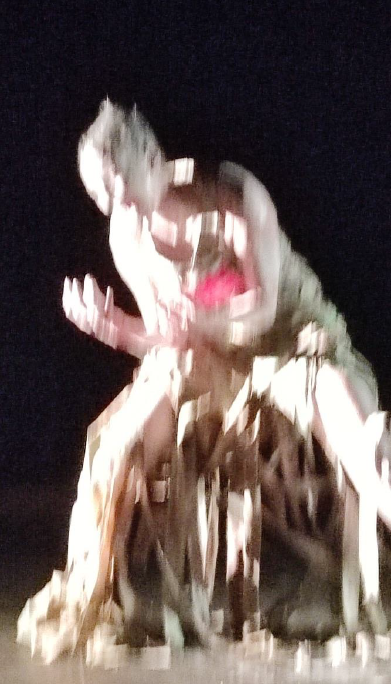
OPEN WINDOW UNIVERSITY RESEARCH INSTITUTE in partnership with UNISA PRESS
Creative and Expressive Arts in Therapy, Education, Professional Practice, Community and African Culture.
Submission of paper delivered at iMPAC 2024 SYMPOSIUM LUSAKA
ABJECT ~ An Irreducible Humanity
Performance art as justice to-come
Tossie van Tonder | Nobonke
Abstract
We live in a time in which the Earth determines everything. As inhabitants, what are we for, then? This paper is an attempt to un-assume ideas of being human. Genre, as-irreducible-humanity performance art expression and practice, interrogates many ontological justifications. Human-centred ideas veer towards illusions of balance, order and control. We require an ontological regulation – with an ethic as much as an expanded vocabulary of expressive being – to dissolve interiority barring an ecological sensibility.
Genre is an artistic praxis to encompass the humanity of an individual while in always new relationality with other humans, and more-than-humans. The focus is on not knowing what you are going to do. Because the Earth determines everything, human presence – embodiment – of being is, at best, a highly idiosyncratic and complex ontology.
The Abject as onto-epistemological ethic of performance expression is offered as a momentary “pause”, a “balancing” of the vast imbalance for a better understanding of the human, the more-than-human, and the more-than-reduced humanity (AI). This art form investigates its theoretical connections with posthuman philosophy, quantum field theory and post-colonial African spirituality. Restoring “human balance” – an ontological blink on a planet in crisis – is an open window, a humble opportunity for existential (well)being. Spectators witness closely – open-hearted, expansive, honest and brave – into the scene everyone gasps at and secretly wants to see. An irreducible humanity is the one who does not point the finger, but the one who ceremoniously, performatively un/becomes, embodying the why now, and the why here, but mostly the why us.
Keywords: embodiment, abject, Genre, ontology, African spirituality, philosopher of the body
Biography
Tossie van Tonder | Nobonke belongs to the Eastern Cape clan, Mjoli, as an elder. She is an independent philosopher of the body and researches bodymind practices for (well)being and transformation. As a practicing clinical psychologist and ontological coach she facilitates new perspectives on parenthood, creativity, and education in a changing global, political, and ecological context. Nobonke has been a veteran, South African dance performer since 1980. As an auto-ethnographer, she performs our being-and-becoming contemporary issues prevalent globally. These focus on gender, racial complexity, ecological realities, and the powers of ageing. Nobonke performs regularly as solo artist and in collaboration with musicians. She has published My African Heart, an intensely personal and poetic South African story about her relationship with a freedom fighter and former political prisoner. In it, she gives a voice to the future spirit child within a complex political context. Her archive can be viewed here.

Ivan Vladislavić1
1. Vladislavić: Buitengewoon doodgewoon. A newspaper article on Vladislavić’s published book The Near North. Rapport Weekliks. 24 March 2024.
1. The creative human body in planetary context
The field of creative and expressive arts has accompanied humankind from ancient times. Today human beings still extend themselves with and as the world into physical, social and spiritual spaces with imagination, inspiration and intuition. The arts afford human creative engagement in an age of planetary crisis.
Performance art plays a vitally materialist role in the exploration of eco-philosophical tenets. These include eco-human binary factors increasingly challenging to the transforming human mind: non-human/human, nature/culture, body/mind, subject/object ... the line between – the inside and the inside of – these dualities progressively erased. Along with the materiality of our world, the human body, here, one in motion – dance – is also evolving as part of the Earth, the solar system (and beyond) and equally, as microbial components the human body is made up of. Moreover, the human body is at once a soulful entity, a physical consistency, a scientific laboratory, a spiritual channel and an intelligibility entangled in the non-human – the more-than human conditions of life on the planet. A person may be intelligent, but engages with the world’s intelligence with intelligibility.
Intelligibility within the posthuman philosophical movement acknowledges that intelligence does not only belong to human beings, but in strong relationality with everything in existence on the planet. It is a heightened ontology vibrantly present in everything: human, non-human and therefore much more-than human.
Considering the human body in this context of intelligibility we refer here to the more-than physical body, in motion with all its components, influenced by and influencing phenomena, as the human bodymind. The contextual dancer could be seen as the intersection of systems upon systems, all of which permeate the dance(r)’s bodymind as matter, as space and as time components in an un/becoming that is inclusive of all vitality known and unknown to humans.
2. Posthuman philosophy2
Feminist, quantum field theorist Karen Barad has contributed generously to undoing the assumptions we have of the human being in a planetary world in crisis, in a discursive discipline termed the posthumanism. They illustrate physical phenomena in human-centred terms to reveal language for an irreducible humanity. (More about this term below.) In a simple experiment of two pebbles falling in a pond at the same time, we observe the overlapping concentric circles as a complex, ongoing, multi-dimensional matter in space and time – diffraction, or infinite interference. This intra-active relationality3of all vitality in the world (and beyond) acknowledges the performativity of everything. Beyond the appropriation of the term by literary and theatre studies, performativity is not the same as performance. The connective intra-action of those multiple waves “constitutes a radical reworking of the traditional notion of causality,” states Barad. “A lively new ontology emerges: the world's radical aliveness comes to light in an entirely nontraditional way that reworks the nature of both relationality and aliveness (vitality, dynamism, agency). This shift in ontology also entails a reconceptualization of other core philosophical concepts such as space, time, matter, dynamics, agency, structure, subjectivity, objectivity, knowing, intentionality, discursivity, performativity, entanglement, and ethical engagement.”4
“All bodies, not merely "human" bodies, come to matter through the world's iterative intra-activity – its performativity.”5
Following the posthuman philosophical movement, including the work of the feminist, vital or (new) materialists, the thinking body of the posthuman dancer acknowledges that dance performance is not merely a human bodymind in motion for aesthetic purposes. Rather, the dancer – this bodymind in motion – per-forms, through form and matter – giving form, removing form, entering and exiting ontologies of existence – life, vitality – dancing as being in manifold spaces and times, creating knowledge as is, as vibrant matter. Performativity is more-than performance, as you may conclude here, rather “a continuous stream of occurrence.”6 Alfred North Whitehead
Jane Bennett positions this (dancing) body in planetary context:
“It is futile to seek a pure nature unpolluted by humanity, and it is foolish to define the self as something purely human. [...] A vital materialism also recasts the self in the light of its intrinsically polluted nature and in doing so recasts what counts as self-interest. [...] [A]n additional tactic in the struggle to remain present to the paradox of a self that is its own outside, is vibrant matter.”7
Therefore at the core of physics, how we speak of the posthuman dancing dancer would be to remove ourselves radically from the notions of the separation of space, time and the matter of the dance(r). Karen Barad coined this continuum of reconfigurations “spacetimemattering”. All of these components that establish the human bodymind as worldly phenomenon are then also doing and undoing matters of human identity – becoming and unbecoming at the same time – and the very foundations of non/being in the age of planetary crisis. Estrangement from and with the self is a radical unsettling of the foundations of meaning. The self becomes conditioned to reconfigurations different from the other social selves, or the self, itself. “The self is dispersed/diffracted through being and time. In an undoing of the inside/outside distinction, it is undecidable whether there is an implosion of otherness, or a dispersion of self throughout spacetimemattering.”8 It might be more accurate to speak of ourselves between the inside (self) and the inside (the planet).
2. Karan Barad, on her coining this term: “As I tried to make clear in my earlier work, “posthumanist” (for lack of a better word when I first used it in 2002) thinking for me is not about moving beyond the human, but rather about understanding how the cut gets made that differentially marks the “human” in relation to its constitutive others. That is, the “posthuman-ist” point is that distinguishing cuts must enter into the frame of analysis rather than beginning the analysis after these divisions are made, thereby enabling an exploration of the limits that human exceptionalism in its differential constitution of the “human” poses to theory construction, political praxis, and scientific practices. See Barad, Meeting the Universe Halfway, esp. pp. 32 and 136, and chapter 4.” Karen Barad What Flashes Up – Theological-Political-Scientific Fragments 2019 p 78.
3. In the posthumanism relations precede parts; the relation exists before the parts come into being. This relationality is intra-active, ongoing, with infinite possibilities within, and, beyond its existence. This collapses linear logic of space and time.
4. Karen Barad. Meeting the Universe Halfway. p 33.
5. Karen Barad. Meeting the Universe Halfway. p 152.
6. Whitehead, Alfred North. Concept of Nature: Tarner Lectures Delivered in Trinity College November 1919. Cambridge: Cambridge University Press, 1920. p 172.
7. Bennett, Jane. Vibrant Matter. A Political Ecology of Things. Duke University Press, 2010. p 116.
8. Karen Barad. What flashes Up. p 195.
3. Genre, a praxis of irreducible humanity
Since this arts-based research practice scarcely belongs to any genre of dance, I term it Genre. The unlearning of Westernised dance technique (classical ballet, European and American contemporary dance technique) affords the posthuman dancer a constancy of new movement vocabularies more authentic to a re-embodiment of an eco-onto-politico-philosophical bodymind. It includes an ontological sphere inclusive of all states of being – embody-able – that embrace a deeper humanity as response-ability (the ability to respond) to, and as deep ecology. Irreducibly, the posthuman dancer wants to get to the heart of all (obsessively capturing everything), whether it is dangerous, difficult, problematic or impossible. A repertoire of authentic emotional resilience expressed through the human face, body, voice, and costume design affords the dancer multiple benefits of the aesthetics of “self-regulation”, one of which is sensing the sense of (well)being. In performance much of this is practiced in real-time composition with mostly African musicians’ and dancers’ bodyminds. The musicians are familiar with a resonance of Africa, as a particularly striving restlessness after an unknown factor, one that influences everything.
In an interview between Barad and Daniela Gandorfer, Barad expresses her view on agency in a manner that depicts the nature of dance and music philosophically: "Agency is a matter of changing the possibilities for change in their materiality. [...] in its multiply expressed desirings for being in connection and collectively reworking the material condition of human and nonhuman lives as well as reworking the very possibilities for change. What is at root in this conception of agency is the dynamism of indeterminacy—that is, intra-activity — which is a reworking of the notion of causality.”9
Performance as Genre is therefore a philosophical quest of mutual sensing in intra-active real-time, therefore improvisational making of matter(ial). The indeterminate nature of this creation is aptly stated by Gamble, Hana and Nail that “performative matter always remains radically entangled and therefore also always partly indeterminate and improvisational.”10 This is the case with matter, as much as the matter of creativity amongst philosophers of the body, and of performance.
9. Karen Barad, Daniela Gandorfer. Political Desirings: Yearnings for Mattering (,) Differently. p 59.
10. Christopher N. Gamble, Joshua S. Hanan & Thomas Nail. WHAT IS NEW MATERIALISM? p 126.

4 "...for Africa" ~ An Irreducible Humanity
Where I live, South Africa, we have a common saying that flows off the tongue whenever something in discussion takes on proportions beyond what can be measured, or described. Even this attempt to write about it, evades examples. “...for Africa” is an exponentially inclusive phenomenon everybody can understand, and seldom questions. Therefore, it generally appears at the end of a sentence ... spoken or written, sung or danced, or strummed.
The performance ABJECT has been, and aims to be performed in African contexts. I believe the Genre oeuvre has a stake in what could be alleged: an inherent African spirituality. As integral part of this performance, the African bodymind is studied, interrogated, entangled, erased, all as iterative practice. It includes history such as the Arab invasions in the north, and the colonial embarkations of Europe into Africa. My personal history over 69 years has formed part of problematizing an auto-ethnographic, post-qualitative movement and performance vocabulary research, Genre. This practice has transformed into an onto-epistemological ethic of un/belonging-as-un/becoming, a vibrancy, a striving “...for Africa” whether it be understood as something I do for a continent, or as a natureculture mycelium: intra-active, diffracting, intelligible performativity as spacetimematter.
But that is not the only artistic and intellectual terrain where African spirituality is being witnessed. “An obsessive need to capture everything is the mark of a certain kind of artist,” marks Ivan Vladislavi?, South African writer. I opine that this obsession is a bodymind one, with a certain sense of sense that certain corners of the South African experience are un/becoming, re-embodied as Genre – an authentic, (human) way of being a phenomenon. Vladislavi? follows with: “Is it any wonder that so many people take pleasure in the simple act of going on foot from one place to another? It is part of the genetic inheritance of our species.”1 But simple acts are most likely deeply human, more-than human, more-than humanity.
At the writing of this paper my 32-year-long relationship with a South African freedom fighter, former political prisoner, and writer intimately embroils my sense of African spirituality once embedded in liberation politics. I am immersed in the direct effects of the once celebrated, but now, perverse notion of political liberation from colonialism. Its neo-colonial manifestations, perverse entanglements with race, class, regurgitated liberation ideology, cadre-ism, disregarded ecological alarms, betrayals and entitled hubris towards the servicing a socio-structural fiber. State-capture has contributed to a different African spirituality unfolding before me.
In this context, South Africa has been left with a neo-spirituality scrambling for its depth and height for over 30 years now. However, what is emerging is a spirit with a differently charged movement. Ardent and highly admirable efforts from individuals, communities and organisations bring an awareness into a heightened and necessary, albeit imminent resolve. The spirit of liberation – so thoroughly informed by ubuntu and freedom from colonialism – is being replaced by a spirit of self-regulation through self-reliance, activism and renewed practices – shapes of Genre – in the spirit of belonging to South Africa. These are often emotional, even cathartic – purgative, iteratively, embodied, attentive – gestures to salvage what is felt as a unique sense of belonging and care for a country, “... for Africa.” I believe these gestures are new embodiments of an African spirituality. Besides its emergence in the general South African community resurrecting fallen towns, and landscapes, it can also be witnessed as artistic phenomena – voice, choirs, music, sculpture, painting, murals, garments, dance, children’s theatre, storytelling and ceremonies, to mention a few. The emotional attention with which these efforts are being conducted has an urgent quality of aspiring transformation to it.
There is a somatic, emotional, psychic and spiritual coagulation needed to overcome a disappointment in the liberation movement. It is a forged national and social survival, one which allows for a variety of spirited expressions. It disrupts the boundaries of convention, tradition, political correctness (inherited from the codifications of the liberation struggle), fears of persecution (against whistle blowing on corruption), psychological appropriateness and physical survival (as hunger strikes for services for the larger ethical entirety.) Often caused by spiritual fatigue and resignation, a certain quality and materiality of African spirituality permeates the young democracy, a kind of magical realism, ever on the edge of its demise, as a unique vitality, engulfed by a refusal to give up the love for a country, called South Africa. The impossible becomes possible. The way to do it is, “... for Africa.”
5. The irreducibly emotional, African Bodymind
I experience my Mjoli clan gatherings in the South African Eastern Cape regularly. Funerals, celebrations and initiations embody the span of human emotions, regardless of age, race, class, religiosity, urban/rural citizenry, political leaning, tribal ranking or personal relevance. Each event is an integral bodymind component of the integrity of the individual’s internalization of the socio-cultural fabric as spacetimemattering.
Some higher forms of understanding can be attained by allowing oneself an entry into extreme states of emotion. This intra-active, diffractive, intelligible collectivity may be seen as forms of compassion, fear, rage, pain, frustration, devastation, elation, grief, surrender, lamentations of helplessness, loss and destruction, exasperation at prevailing asymmetries, state violence on citizens, atrocities of injustice, mourning the irrevocable roots of conflict, holding with all powers possible irreconcilable paradoxes, resignation and complex configurations of bodymind emotions mostly evident in states of conflicting significance. In these states, together with my clan, I often call upon animate forces to help us, to see the bigger picture anew, a call for the inherent justice within the national narrative. I impress upon the reader to see these as simple acts of an irreducible humanity.
Witnessing myself and others during these events, I notice an ontological shift with concomitant relationality to people and more-than people marking various forms of cleansing, purgation, invigoration and mostly a sense of healing in weeks following. These emotional processes generally have a vague beginning, building up to cathartic extremes sustained with fervor while the integrity of emotion is still present, guiding the subtle shifts in expression as movement, voice, song, words, facial contortions, repetitive mantras and often extreme states of embodiment that appear sub- or superhuman for witnesses. Exiting the state may take a long time or could simply be stepped out of. As vital, materialist experience it calls up analogously, the posthumanist, quantum field theory. “Bound up in this tiniest bit of matter, this mere fragment of an atom, is a material force so enormous that its release could reconfigure the material conditions of possibility, the very fabric of spacetimemattering, producing a revolutionary chance in the present, in this moment of now-time.”11
In the African practice of Genre as performance art, performers enter the performance spacetimematter with the authentic intra-active presence of witnesses, others present – a specific zone of Africanity, “... for Africa”. The potential for restoring a sense of balance – (well)being – is imminent. This imminent vitality depends upon a personal and collective embrace, call it ubuntu12, of not only people, or more-than people, but an irreducible humanity. When emotional content is released, it is never the same as before. This is where the abject un/becoming, un/belongs.
11. Karen Barad. What Flashes Up: Theological-Political-Scientific Fragments p 25.
12. "I am because of you", an integral facet of African spirituality.
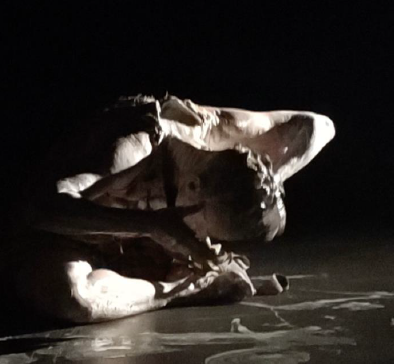
6. Abject13: Nature and culture as always, increasingly diffracted through each other.
This paper focusses on a territory of art performance investigation, the abject. From the human perspective, the abject could be seen as everything that repulses, the horror that we face with repugnance, that which revolts – and that makes us sick, unwell. Here are some territories of (the) abject. Political abject is evident in corruption, state-based violence, election promises that are not realised, crimes with no consequence, and a disinterest, or supposed inability to overturn the reality of environmental degradation brought about by humankind causing planetary destruction. As such, the abject has become an integral experience of being human. Another example: The air and atmospheres we inhabit is infused with contemporary air and atmospheric crises. Air has become non-transparent, has disappeared in favour of air filters, purifiers or privileged affordances of clean-er air. The human bodymind is toxified by polluted air. Our atmospheres are abject. This list of abject is extensive. It includes the human bodymind.
The effect of the abject on – and as – the bodymind does not merely manifest as a physical repository. With the planet in crisis, the human self-regulating capacities to adjust to abject circumstances are reducing as you read these words. One of the psycho-physiological results is what could be referred to as a troubled, negative self-image – feeling bad about the self – and not capable of doing anything about it. Because the abject in all its manifestations becomes increasingly ubiquitous, the bodymind too, is affected. To know how to make sense of this abject human-planetary crisis becomes increasingly troubling.
Rather than being a mere recipient of circumstances, knowing what to do in return grants a person greater resources. However, in the light of vastly revolving Earth-bound phenomena such as climate change, reduction of bio-diversity, loss of species and toxic air and water sources, relying on the human individual to “know what to do to with what happens to you” is like asking an elephant with limited angles of vision to time its escape in bright light with acuity, staring into the poacher’s sniper rifle with semi-automatic action, fitted with a telescopic sight for extreme accuracy and chambered for a high-ballistic performance. The Earth crisis is the determiner of everything. Humanity is learning as this condition, abject.
Populist oppositions against the abject – protests against poor service delivery, coal-based energy, official offences that abjectively offend, and, for climate urgency – are retorts against that which “makes people sick.” Groups have spanned their inherent resourcefulness, going on hunger strikes, engaging in mass suicides (such as Indian farmers against government policies impoverishing their food makers), not to mention the disrupting and compelling telos of mass migrations across land and seas with unremitting abject consequences. These are response-able acts of climate urgency in migrants’ home countries.
Abject is non-binary. The life of the Earth so deeply and thoroughly infused with abject factors, and our own recipiency and participatory abject ontology do not leave the human bodymind much alternatives. Attempting to transcend the abject with its exponential dystopian wave of perturbances, is like not knowing that the wave breaking at the shore, is the ocean. When the polluting object observed by the human subject permeates the human condition, when the acidifying ocean renders an increasing population of fish extinct, and the object can no longer be seen as there, the object/subject siblinghood of previous centuries, collapses. The result is called abject. The critical realisation of this crisis, evocative of the infinitely iterative abject, is (the) abject. In other words, the inability to distinguish ourselves from our environment, not knowing what to do with what happens... immerses the human being in abject.
It is this human condition – becoming abject through abject circumstance awareness, abject politics, abject relationality with human and non-human, and, more-than human – players, embodying the abject that is part of a certain un/being and un/becoming – that is being explored in a series of performances.
13. I am indebted to French philosopher, psycho-analyst, feminist Julia Kristeva for my first introduction to the abject in her book: Powers of Horror, An Essay on Abjection. Columbia University Press New York 1982.
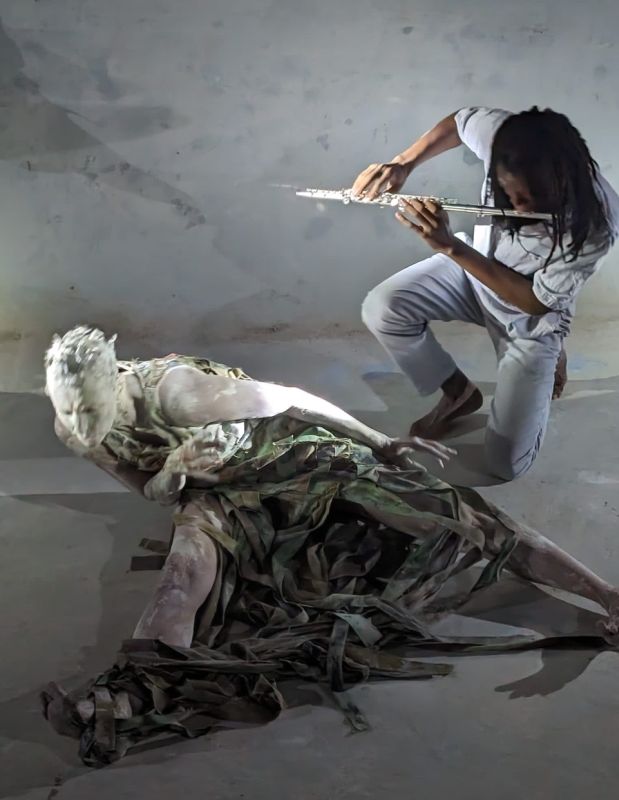
7. ABJECT ~ An Irreducible Humanity, performance art “for Africa”.
This performing phenomenon is an event with performing artists and attending witnesses present. The performers’ instruments are their bodymind and musical instruments. All and everything present constitutes a spacetimemattering, a vibrant materiality as constellation in space and time. During the South African and Zambian iterations early in 2024 the irreducible humanity emerging rested on two performing artists – a musician14and a dancer, myself – creating an event together in real-time composition15. This included artists’ ontological, epistemological, political, spiritual and imminent embeddedness in the postanthropocene.16 17 One could constitute a score18 that would direct our creative input, a dedication to the creative process itself. But this score could exist, or not. To different degrees we stepped onto a platform – a theatre stage; a derelict, empty swimming pool – without a score, having barely met, little shared history, immersing ourselves in the unknown out of which we would embody the abject. This was artistically brave, if not dangerous, and “dangerous” aesthetically, daring the spacetimemattering with our respective and merging onto-ethico-epistemologies. The generativity of creating ceaselessly new forms – Whitehouse’s “continuous stream of occurrence” – required a deep commitment to the abject of our humanity. This ontology is trusted as being present in all and everything. For us as artists an innate listening, attunement and ethic of being in the abject moment, was being embedded in the moment of creation. Manifold trajectories would emerge. However, these trajectories were guided by an artistic diligence to follow our own epistemology, ethics and ontology immersed in an embodied postanthropocene.
Some people think this work is liminal. I agree. It is dangerous to be on the unknown edge. The self is exposed and free-roaming. Some equate it with planting an unfamiliar seed. But here I have a different take. A seed falls and with a bit of help from the atmospheres it becomes millions of seeds over time, robust, resilient, restorative, reinvigorated – irreducible. Like the Earth, we live with what we create. Even though there is a degree of self-awareness, becoming distractively self-conscious (ontologically preoccupied) is dangerous. Again, the focus is on not knowing what you are going to do, an intra-active intelligibility, relationality diffracted through with Earth, witnesses, spacetimemattering, “... for Africa” because Earth Determines Everything. But we are response-able for every act of creation as harboring an authenticity of expressibility. Karen Barad follows this ethic in her crafting of posthuman theory: “I am trying to be in touch with the theory in the way it inhabits me and that I am inhabiting it—the way in which we inhabit each other in this strange topology, this material, embodied sense of sense-making. I am trying to do it in a response-able way with as much precision as possible.”19 Again, the “obsessive need to capture everything”, according to SA writer Vladislavi?.
14. Musicians: during the Cape Town performance Francois le Roux, cellist; and, Lusaka performance Clarke Nchimunya Siachaba, flautist.
15. Formerly known as “improvisation.”
16. The Anthropocene marks the epoch of human influence on the Earth planet. The postanthropocene acknowledges the role of technology, such as Artificial Intelligence, that renders governments incapable to govern technology and where progress becomes destruction especially since humankind will not stop before the chasm.
17. Please note that the performance also included a lighting technician of the Theatre Arts in Cape Town, and four students of Open Window University, Lusaka, improvising with hand-held torches inside a derelict swimming pool in a derelict holiday lodge. Participants also included witnesses and extended to structures, their post/colonial significance, art-making during festivals, the bricks, murals, curtains, neon lights, history of workers building the site, colonial settlement, wars, the full moon over the empty pool in silence and everything not mentioned here.
18. “Score” is a dance term implying an agreement between artists, a frame to which they abide mostly for technical learning and progression purposes. A “score” could delimit the time of a performance, the spatial demarcations, or any agreements regarding the manner of their execution. It may even include the refusal to have a score.
19. Karen Barad, Daniela Gandorfer. Political Desirings: Yearnings for Mattering (,) Differently Theory & Event, Volume 24, Number 1, January 2021, pp. 14-66 (Article) Published by Johns Hopkins University Press. p 42.
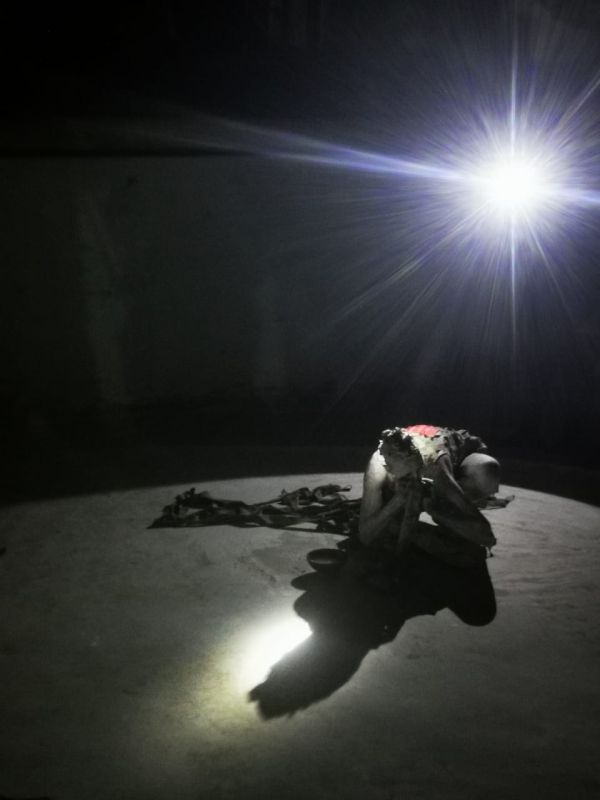
8. "Justice to-come"
In performance art work in the genre of Genre, where the performer’s onto-ethico-politico-epistemology is an intrinsic and intentional information/knowledge making of the world – worlding – this theatrical “obsessive need to capture everything” is an embodiment of a future-making of imminent proportions. The ground here is justice. Since every minute act is being response-able for an ethic of being, and thus for worlding in a world, “we” as participants11 do not pre-exist, nor stand external, nor sit separable from what we create. Philosophically, “we” are everything, come with a past that is not yet over, issues unresolved, politics – infinitely entangled, void and being interrogated for who, what, why, how of our actions. ‘What are we for?’ is my obsessive material-discourse. The materialisation of the meaning I make as performer swims in a “justice to-come”.20
Dance as justice does not pose as an obvious rhetoric of popular political posturing in the 21st century. On the contrary, the embodiment by bodyminding the entanglements essential to facing profound questions of justice entails an organic obsessional engagement within a praxis such as Genre. One does not know what issue you enter. Instead, the issue captures you, and engulfs the performer with a sense of the infinite, which the dance(r) is response-able for. The wave you think you are, is the ocean.
Genre “yearns” as a “download”, a performativity of all psycho-politico-socio-techno-eco-spiritual contents present-past-future, emanating from everything and all present, acknowledging the unseen and the vast revolutions of being a solar system within other systems, yet calibrating intimately with the microbial life that keeps all alive. Consider this “download” in every act of this performativity. As such: “Justice is always to-come, and always a matter of an incalculable number of entanglements.”21
This embracing philosophical underpinning of ABJECT, the performance, is an ever-growing body of work, penetration of thought, doing and undoing experiential embodiment, relational enmeshment within the potentiality of every facet, un/fulfilled. Consider the humanity embedded in this wide philosophical bodymindscape, its encounters and interactions, its (wave-like) intra-action, its iterations of revolving significance that leaves us with no other view than that of An Irreducible Humanity.
20. This concept is an agential force in feminist, quantum physicist, scientist Karen Barad’s work; and, as dancer it underlies my work of embodiment as ethic of worlding. See Barad, “Quantum Entanglements and Hauntological Relations of Inheritance: Dis/continuities, SpaceTime Enfoldings, and Justice-to-Come, Derrida Today 3, no. 2 (November 2010): 240-268.
21. Barad in interview with Gandorfer, Political Desirings: Yearnings for Mattering (,) Differently Karen Barad, Daniela Gandorfer Theory & Event, Volume 24, Number 1, January 2021, pp. 14-66 (Article) Published by Johns Hopkins University Press. p 33.
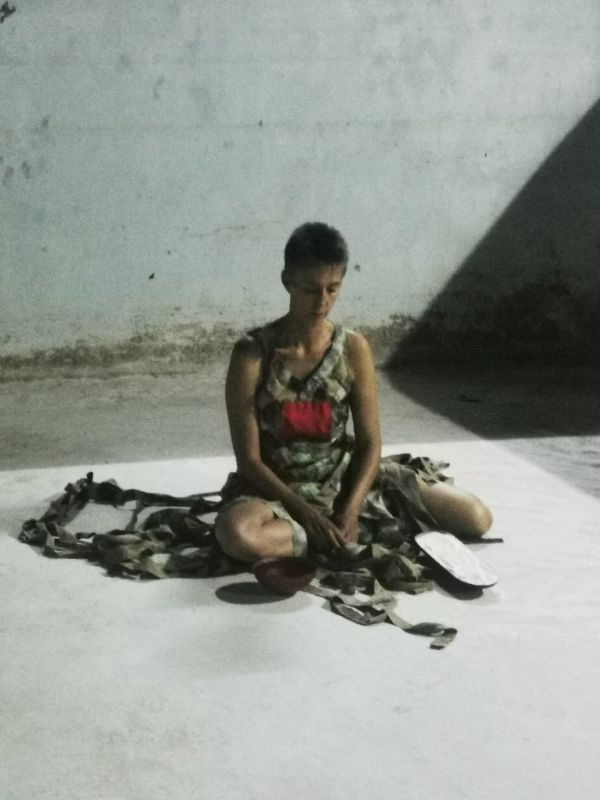
9. Conclusion
In this paper I aimed to think the thinking underneath an art form – performance – with the ethical responsibility practiced as Genre, an embodiment of “justice to-come.” The bodymind as a particular humanity is constantly unfolding as irreducible when entering the authenticity of what we know, think and believe with intelligibility with everything. This means that we create a world from that which we are. Should we enter this creation as aesthetic practice, we are also in the practice of embodying the world as abject/s, as that which the human may not be able to know, or withstand, or willingly express. ABJECT is a series of on-going performances where this practice is an ethic for justice to-come.
10. Afterword
Genre could be in practice at this spacetimemattering of your reading. If you feel the effects of this reading within your bodymind, refrain from scrolling back or on. Advance what you sense by enhancing the physicality thereof – a trembling, slow back-and-forth movement, a contraction of muscles, or expansion, any existing movement. This is how easy Genre works. You are basically behaving as yourself. Problems dissolve.
For the further Q&A exposition of this performance work, please consult this web page →
All images by Kali van der Merwe.
RESOURCES
Karen Barad. Meeting the Universe Halfway. Quantum Physics and the Entanglement of Matter and Meaning. Duke University Press, Durham & London 2007.
Barad. “Quantum Entanglements and Hauntological Relations of Inheritance: Dis/continuities, SpaceTime Enfoldings, and Justice-to-Come, Derrida Today 3, no. 2 (November 2010).
Barad. What Flashes Up – Theological-Political-Scientific Fragments 2019. Fordham University. URL: https://www.jstor.org/stable/j.ctt1xhr73h.4 →
Karen Barad and Daniela Gandorfer. Political Desirings: Yearnings for Mattering (,) Differently Theory & Event, Volume 24, Number 1, January 2021, pp. 14-66 (Article) Published by Johns Hopkins University Press.
Jane Bennett. Vibrant Matter. A Political Ecology of Things. Duke University Press, 2010.
Christopher N. Gamble, Joshua S. Hanan & Thomas Nail. WHAT IS NEW MATERIALISM? (2019), Angelaki, 24:6, 111-134, DOI: 10.1080/0969725X.2019.1684704
Julia Kristeva. Powers of Horror, An Essay on Abjection. Columbia University Press New York 1982.
Ivan Vladislavić. Buitengewoon doodgewoon. A newspaper article on Vladislavi?’s published book The Near North. Rapport Weekliks. 24 March 2024.
Alfred North Whitehead. Concept of Nature: Tarner Lectures Delivered in Trinity College November 1919. Cambridge: Cambridge University Press, 1920.
